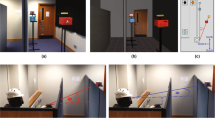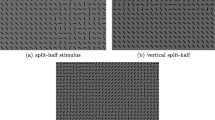Abstract
We report on the ability of human observers in judging their direction of translation from sparse, moving random dot patterns for varying extents of 3-D rotation. The observers have to discriminate possible axes of translation with angular separations of 2.5 deg or 5 deg. The field of view is either 20x20 deg or 10x10 deg. The simulated observer movement is relative to two types of scenes. The first type consists of dots located on a single plane at a depth Z. The second type of scenes consists of dots located on two transparent planes at different depths Z and Z+dZ.
Unlike in the single plane condition, where the judgements about the direction of translation deteriorate quickly as the magnitude of 3-D rotation increases, we find for movements relative to planes at different distances a stable performance over a range of rotational magnitudes. Moreover we find that a reduction of the field of view from 20x20 deg to 10x10 deg does not affect the judgements significantly.
Similar content being viewed by others
References
Cutting JE (1983) Perceiving and recovering structure from events. Proc ACM SIGGRAPH/SIGART Conf on Motion, pp 141–147
Doorn AJ van, Koenderink JJ (1982) Visibility of movement gradients. Biol Cybern 44:167–175
Gibson JJ (1950) The perception of the visual world. Houghton Mifflin Company, Boston Riverside Press, Cambridge
Gibson JJ (1958) Visually controlled locomotion and visual orientation in animals. Br J Psychol 49:182–194
Haddad GM, Steinman RM (1973) The smallest voluntary saccade: implications for fixation. Vis Res 13:1075–1086
Johnston IR, White GR, Cumming RW (1973) The role of optical expansion patterns in locomotor control. Am J Psychol 86:311–324
Kelly DH (1985) Visual processing of moving stimuli. J Opt Soc Am A 2: 216–225
Lawton DT (1982) Motion analysis via local translational processing. Proc IEEE Workshop on Computer Vision: Representation and Control, pp 59–72
Llewellyn KR (1971) Visual guidance of locomotion. J Exp Psychol 91:245–261
Longuet-Higgins HC (1981) A computer algorithm for reconstructing a scene from two projections. Nature 293:133–135
Regan D, Beverley KI (1982) How do we avoid confounding the direction we are looking and the direction we are moving? Science 215:194–196
Rieger JH, Lawton DT (1985) Processing differential image motion. J Opt Soc Am A 2:354–360
Tsai RY, Huang TS (1981) Estimating three-dimensional motion parameters of a rigid planar patch. I. IEEE Trans. ASSP-29, pp 1147–1152
Warren R (1976) The perception of egomotion. J Exp Psychol [Human Percept] 2:448–456
Author information
Authors and Affiliations
Rights and permissions
About this article
Cite this article
Rieger, J.H., Toet, L. Human visual navigation in the presence of 3-D rotations. Biol. Cybern. 52, 377–381 (1985). https://doi.org/10.1007/BF00449594
Received:
Issue Date:
DOI: https://doi.org/10.1007/BF00449594




